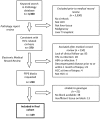Host genetics predict clinical deterioration in HCV-related cirrhosis
- PMID: 25504078
- PMCID: PMC4264769
- DOI: 10.1371/journal.pone.0114747
Host genetics predict clinical deterioration in HCV-related cirrhosis
Abstract
Single nucleotide polymorphisms (SNPs) in the epidermal growth factor (EGF, rs4444903), patatin-like phospholipase domain-containing protein 3 (PNPLA3, rs738409) genes, and near the interleukin-28B (IL28B, rs12979860) gene are linked to treatment response, fibrosis, and hepatocellular carcinoma (HCC) in chronic hepatitis C. Whether these SNPs independently or in combination predict clinical deterioration in hepatitis C virus (HCV)-related cirrhosis is unknown. We genotyped SNPs in EGF, PNPLA3, and IL28B from liver tissue from 169 patients with biopsy-proven HCV cirrhosis. We estimated risk of clinical deterioration, defined as development of ascites, encephalopathy, variceal hemorrhage, HCC, or liver-related death using Cox proportional hazards modeling. During a median follow-up of 6.6 years, 66 of 169 patients experienced clinical deterioration. EGF non-AA, PNPLA3 non-CC, and IL28B non-CC genotypes were each associated with increased risk of clinical deterioration in age, sex, and race-adjusted analysis. Only EGF non-AA genotype was independently associated with increased risk of clinical deterioration (hazard ratio [HR] 2.87; 95% confidence interval [CI] 1.31-6.25) after additionally adjusting for bilirubin, albumin, and platelets. Compared to subjects who had 0-1 unfavorable genotypes, the HR for clinical deterioration was 1.79 (95%CI 0.96-3.35) for 2 unfavorable genotypes and 4.03 (95%CI 2.13-7.62) for unfavorable genotypes for all three loci (Ptrend<0.0001). In conclusion, among HCV cirrhotics, EGF non-AA genotype is independently associated with increased risk for clinical deterioration. Specific PNPLA3 and IL28B genotypes also appear to be associated with clinical deterioration. These SNPs have potential to identify patients with HCV-related cirrhosis who require more intensive monitoring for decompensation or future therapies preventing disease progression.
Conflict of interest statement
Figures


Similar articles
-
Impact of EGF, IL28B, and PNPLA3 polymorphisms on the outcome of allograft hepatitis C: a multicenter study.Clin Transplant. 2016 Apr;30(4):452-60. doi: 10.1111/ctr.12710. Epub 2016 Mar 1. Clin Transplant. 2016. PMID: 26854475 Free PMC article.
-
Impact of the Uridine⁻Cytidine Kinase Like-1 Protein and IL28B rs12979860 and rs8099917 SNPs on the Development of Hepatocellular Carcinoma in Cirrhotic Chronic Hepatitis C Patients-A Pilot Study.Medicina (Kaunas). 2018 Sep 27;54(5):67. doi: 10.3390/medicina54050067. Medicina (Kaunas). 2018. PMID: 30344298 Free PMC article.
-
Influence of interleukin-28B single-nucleotide polymorphisms on progression to liver cirrhosis in human immunodeficiency virus-hepatitis C virus-coinfected patients receiving antiretroviral therapy.J Infect Dis. 2011 Jun 1;203(11):1629-36. doi: 10.1093/infdis/jir113. J Infect Dis. 2011. PMID: 21592993
-
Interleukin-28B TT genotype is frequently found in patients with hepatitis C virus cirrhosis but does not influence hepatocarcinogenesis.Clin Exp Med. 2017 May;17(2):217-223. doi: 10.1007/s10238-016-0418-1. Epub 2016 Apr 15. Clin Exp Med. 2017. PMID: 27083168
-
No correlation between PNPLA3 rs738409 genotype and fatty liver and hepatic cirrhosis in Japanese patients with HCV.PLoS One. 2013 Dec 11;8(12):e81312. doi: 10.1371/journal.pone.0081312. eCollection 2013. PLoS One. 2013. PMID: 24349054 Free PMC article.
Cited by
-
Impact of EGF, IL28B, and PNPLA3 polymorphisms on the outcome of allograft hepatitis C: a multicenter study.Clin Transplant. 2016 Apr;30(4):452-60. doi: 10.1111/ctr.12710. Epub 2016 Mar 1. Clin Transplant. 2016. PMID: 26854475 Free PMC article.
-
Impact of hepatitis C virus eradication on hepatocellular carcinogenesis.Cancer. 2015 Sep 1;121(17):2874-82. doi: 10.1002/cncr.29528. Epub 2015 Jun 16. Cancer. 2015. PMID: 26079399 Free PMC article. Review.
-
A common variant in PNPLA3 is associated with age at diagnosis of NAFLD in patients from a multi-ethnic biobank.J Hepatol. 2020 Jun;72(6):1070-1081. doi: 10.1016/j.jhep.2020.01.029. Epub 2020 Mar 5. J Hepatol. 2020. PMID: 32145261 Free PMC article.
-
Impact of the Uridine⁻Cytidine Kinase Like-1 Protein and IL28B rs12979860 and rs8099917 SNPs on the Development of Hepatocellular Carcinoma in Cirrhotic Chronic Hepatitis C Patients-A Pilot Study.Medicina (Kaunas). 2018 Sep 27;54(5):67. doi: 10.3390/medicina54050067. Medicina (Kaunas). 2018. PMID: 30344298 Free PMC article.
-
Duplex High-Resolution Melting Assay for the Simultaneous Genotyping of IL28B rs12979860 and PNPLA3 rs738409 Polymorphisms in Chronic Hepatitis C Patients.Int J Mol Sci. 2015 Sep 14;16(9):22223-42. doi: 10.3390/ijms160922223. Int J Mol Sci. 2015. PMID: 26389885 Free PMC article.
References
-
- Charlton M (2001) Hepatitis C Infection in Liver Transplantation. American Journal of Transplantation 1:197–203. - PubMed
-
- (1997) National Institutes of Health Consensus Development Conference Panel statement: Management of hepatitis C. Hepatology 26:2S–10S. - PubMed
-
- D'Amico G, Garcia-Tsao G, Pagliaro L (2006) Natural history and prognostic indicators of survival in cirrhosis: A systematic review of 118 studies. Journal of Hepatology 44:217–231. - PubMed
-
- Huang H, Shiffman ML, Friedman S, Venkatesh R, Bzowej N, et al. (2007) A 7 gene signature identifies the risk of developing cirrhosis in patients with chronic hepatitis C. Hepatology 46:297–306. - PubMed
-
- Ge D, Fellay J, Thompson AJ, Simon JS, Shianna KV, et al. (2009) Genetic variation in IL28B predicts hepatitis C treatment-induced viral clearance. Nature 461:399–401. - PubMed
Publication types
MeSH terms
Grants and funding
LinkOut - more resources
Full Text Sources
Other Literature Sources
Medical

